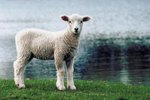
Don't overlook the value of owning sheep. They're terrific landscapers, eating weeds up at which most other grazing herbivores turn their noses, and they're a source of nutritious dairy products like cheese and milk. Shearing them will be part of your duties. Shearing relieves your sheep of heavy insulation when winter's over and provides you with a salable commodity.
Springtime Shearing
Early spring is typically the time of year for sheep-shearing. This relieves the sheep of their year-old coats in time to keep them cool and comfortable, and gives them plenty of time to grow a coat that's long and heavy for the winter. Shearing may begin in March unless the weather is particularly mild, in which case producers sometimes begin shearing toward the end of February. Shearing timing has a lot to do with the lambing season, too. Shearing pregnant sheep about a month before their lambs are due encourages ewes to take shelter, so their lambs aren't born outside. Shearing also stimulates ewes to eat more just before lambing, which provides nutrients to Mama sheep and her baby, establishes a more hygienic environment for the lamb to be born in, and clears the way for easy nursing once the baby has arrived.
Frequency
Most sheep grow out their fleece all year long with only an annual shearing to look forward to. Certain types of sheep, however, can be sheared up to twice a year; others don't require shearing at all. Carpet wool sheep, whose coarse, low-grade wool is used in carpets, are sheared in April and again in fall, around August or September. Shedding sheep, on the other hand, shed their coats naturally and don't need to be sheared.
Do It Yourself or Hire?
Having a flock of sheep doesn't mean you have shear them yourself. Shearing pros will come to you to shear them for a fee. The shearing process requires specialized equipment that must be maintained for efficient shearing, not to mention requires know-how and experience to competently shear sheep without nicking, cutting or otherwise harming them. If you intend to shear your sheep yourself, get thorough and proper training from a professional or through a county extension school, and buy the appropriate tools.
Preparing the Flock
Whether you'll be shearing your sheep or hiring someone, prepare your flock for shearing day. Keep your sheep dry for a day or two prior to shearing, as wet and even damp sheep cannot be sheared. Don't feed or water your sheep for a minimum of 12 hours before shearing so their stomachs aren't full and they'll be able to sit, turn and bend more comfortably. Prior to shearing, keep your sheep away from materials like poly tarp and poly twine so it doesn't become stuck to your sheep's fleece and mix in with the wool during shearing. Immediately after shearing each specimen, give it access to food and water. Ensure they all have sufficient shelter for at least the first few days they are without their wool.
References
- Running a Small Flock of Sheep; David G. Hinton
- UT Extension: Sheep Management Calendar
- North Dakota State University Agriculture Communication: Shear Sheep Before Lambing
- Oregon State University: Sheep Management Calendar
- Sheep101.info: Counting Sheep
- Sheep101.info: "Naked" Sheep
- Azerbaijan Rugs: Shearing Wool
- FAO.org: Wool, Meat and Milk Yield From Carpet Wool Sheep Breeds in the Mediterranean
Photo Credits
-
Ryan McVay/Photodisc/Getty Images
Writer Bio
Elle Di Jensen has been a writer and editor since 1990. She began working in the fitness industry in 1987, and her experience includes editing and publishing a workout manual. She has an extended family of pets, including special needs animals. Jensen attended Idaho and Boise State Universities. Her work has appeared in various print and online publications.




